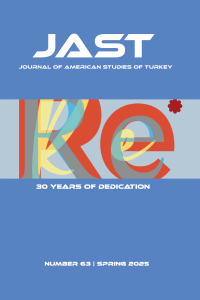Louis Armstrong and Zora Neale Hurston: on the Re-Calibration of Time in Early Twentieth Century America
Öz
This paper explores the re-conception of time in Modernist America's music and literary arts. Beyond tempo, time encompasses the organization of rhythmic elements that create motion and counter-motion, allowing the interplay of voices to express complex patterns and themes. Time can be seen as a flexible framework that outlines the possible movements of musical notes or narrative moments. Louis Armstrong established a model for musical phrasing that guided jazz soloists throughout the twentieth century. His solos challenged mechanical clock time by creating melodic conversations in a more fluid temporal shape. This resulted in a personal and unique voice, utilizing shifting nodes of time to achieve an unprecedented degree of expression. Similarly, Zora Neale Hurston restructured time in her novel Their Eyes Were Watching God through the use of music, reflecting characters’ inner experiences and the rhythms of life. Hurston diverged from canonical rhythm and form, drawing on the speech patterns of southern rural blacks to expand her rhythmic and expressive possibilities. This irregular speech introduced alternative rhythms, allowing Hurston to create new voices on both individual and communal levels. Together, Armstrong and Hurston illustrate how re-calibrating time in their respective arts created innovative and expressive forms, enriching the cultural landscape of early twentieth-century America.
Anahtar Kelimeler
Louis Armstrong Zora Neale Hurston Time Rhythm Dixieland Jazz
Etik Beyan
-
Destekleyen Kurum
-
Proje Numarası
-
Teşekkür
-
Kaynakça
- Armstrong, Louis. Hot Fives and Sevens. Vol. 2, JSP Records, 1999. CD.
- Bach, Johann Sebastian. J. S. Bach: Orchestral Suites Nos. 2 and 3. Performed by the Berlin Philharmonic Orchestra. Deutsche Grammophon, 1975.
- Bergson, Henri. Time and Free Will: An Essay on the Immediate Data of Consciousness. Translated by F. L. Pogson, Allen and Unwin, 1950.
- Einstein, Albert. Relativity: The Special and General Theory. Translated by Robert W. Lawson, 3rd ed., Methuen, 1920.
- Ellison, Ralph. Invisible Man. Vintage, 1972.
- Germana, Michael. “Ellison’s Durational View of Bebop.” Ralph Ellison in Context, edited by Paul Devlin, Cambridge UP, 2022.
- Giddens, Gary. Visions of Jazz: The First Century. Oxford UP, 1998.
- Gilbert, David. The Product of Our Souls: Ragtime, Race, and the Birth of the Manhattan Musical Marketplace. U of North Carolina P, 2015.
- Hurston, Zora Neale. Their Eyes Were Watching God. Harper & Row, 1995.
- Jasen, David A. and Gene Jones. Black Bottom Stomp: Eight Masters of Ragtime and Early Jazz. Routledge, 2002.
- Jazz, directed by Ken Burns, part 3: “Our Language,” PBS Home Video, 2004. DVD.
- Oliver, Paul. “Under the Chicken Tree: Songs from the Ragtime Era.” Songsters and Saints: Vocal Traditions on Race Records. Cambridge UP, 1984.
- Palmer, Robert. Deep Blues. Penguin, 1982.
- Peretti, Burton W. Lift Every Voice: The History of African American Music. Rowman & Littlefield Publishers, 2008.
- Schuller, Gunther. Early Jazz: Its Roots and Musical Development. Revised ed., Oxford UP, 1986.
- Wondrich, David. Stomp and Swerve: American Music Gets Hot, 1843–1924. Chicago Review Press, 2003.
- Zeyl, Donald J. “Introduction.” Timaeus, by Plato, translated by Donald J. Zeyl, Hackett Publishing Company, 2000, pp. ix–xxvii.
- Zimmerman, Katherine Anne. The Sounds of Zora Neale Hurstonʼs Their Eyes Were Watching God: Blues, Rhythm, Rhyme and Repetition. MA Thesis, The University of North Carolina at Greensboro, 2013.
Öz
Proje Numarası
-
Kaynakça
- Armstrong, Louis. Hot Fives and Sevens. Vol. 2, JSP Records, 1999. CD.
- Bach, Johann Sebastian. J. S. Bach: Orchestral Suites Nos. 2 and 3. Performed by the Berlin Philharmonic Orchestra. Deutsche Grammophon, 1975.
- Bergson, Henri. Time and Free Will: An Essay on the Immediate Data of Consciousness. Translated by F. L. Pogson, Allen and Unwin, 1950.
- Einstein, Albert. Relativity: The Special and General Theory. Translated by Robert W. Lawson, 3rd ed., Methuen, 1920.
- Ellison, Ralph. Invisible Man. Vintage, 1972.
- Germana, Michael. “Ellison’s Durational View of Bebop.” Ralph Ellison in Context, edited by Paul Devlin, Cambridge UP, 2022.
- Giddens, Gary. Visions of Jazz: The First Century. Oxford UP, 1998.
- Gilbert, David. The Product of Our Souls: Ragtime, Race, and the Birth of the Manhattan Musical Marketplace. U of North Carolina P, 2015.
- Hurston, Zora Neale. Their Eyes Were Watching God. Harper & Row, 1995.
- Jasen, David A. and Gene Jones. Black Bottom Stomp: Eight Masters of Ragtime and Early Jazz. Routledge, 2002.
- Jazz, directed by Ken Burns, part 3: “Our Language,” PBS Home Video, 2004. DVD.
- Oliver, Paul. “Under the Chicken Tree: Songs from the Ragtime Era.” Songsters and Saints: Vocal Traditions on Race Records. Cambridge UP, 1984.
- Palmer, Robert. Deep Blues. Penguin, 1982.
- Peretti, Burton W. Lift Every Voice: The History of African American Music. Rowman & Littlefield Publishers, 2008.
- Schuller, Gunther. Early Jazz: Its Roots and Musical Development. Revised ed., Oxford UP, 1986.
- Wondrich, David. Stomp and Swerve: American Music Gets Hot, 1843–1924. Chicago Review Press, 2003.
- Zeyl, Donald J. “Introduction.” Timaeus, by Plato, translated by Donald J. Zeyl, Hackett Publishing Company, 2000, pp. ix–xxvii.
- Zimmerman, Katherine Anne. The Sounds of Zora Neale Hurstonʼs Their Eyes Were Watching God: Blues, Rhythm, Rhyme and Repetition. MA Thesis, The University of North Carolina at Greensboro, 2013.
Ayrıntılar
| Birincil Dil | İngilizce |
|---|---|
| Konular | Edebi Çalışmalar (Diğer) |
| Bölüm | Research Articles |
| Yazarlar | |
| Proje Numarası | - |
| Erken Görünüm Tarihi | 30 Haziran 2025 |
| Yayımlanma Tarihi | 30 Haziran 2025 |
| Gönderilme Tarihi | 19 Mart 2025 |
| Kabul Tarihi | 4 Haziran 2025 |
| Yayımlandığı Sayı | Yıl 2025 Sayı: 63 |
JAST - Journal of American Studies of Turkey


